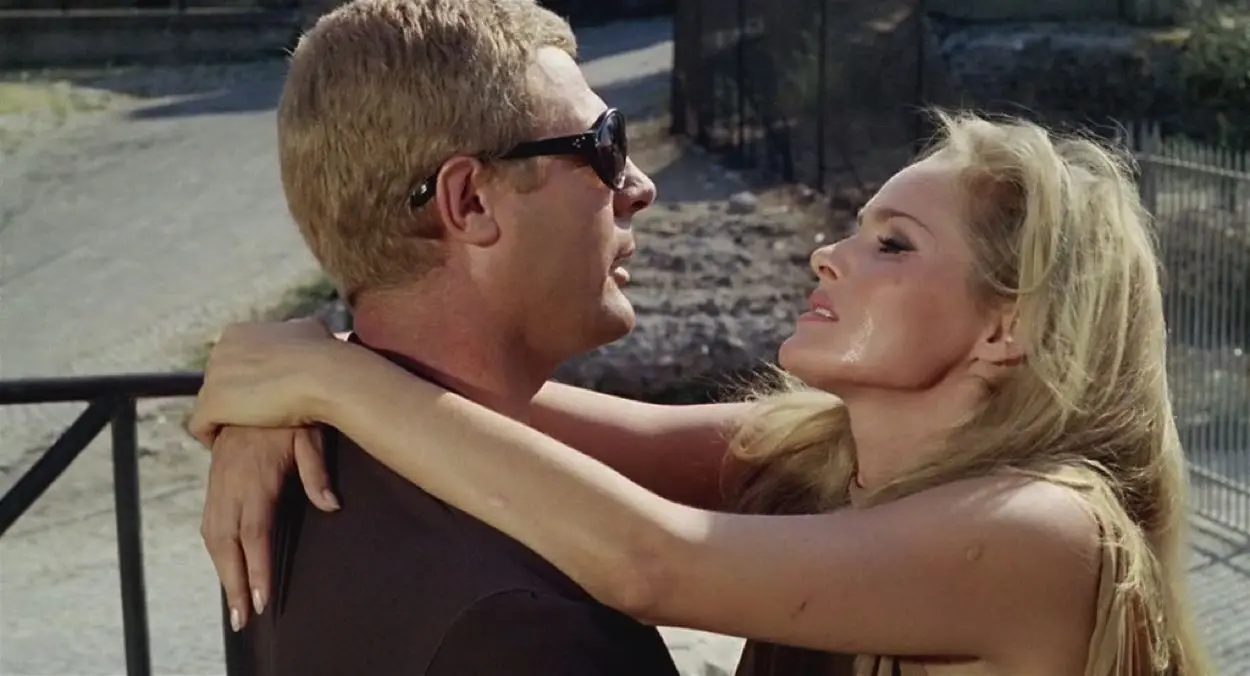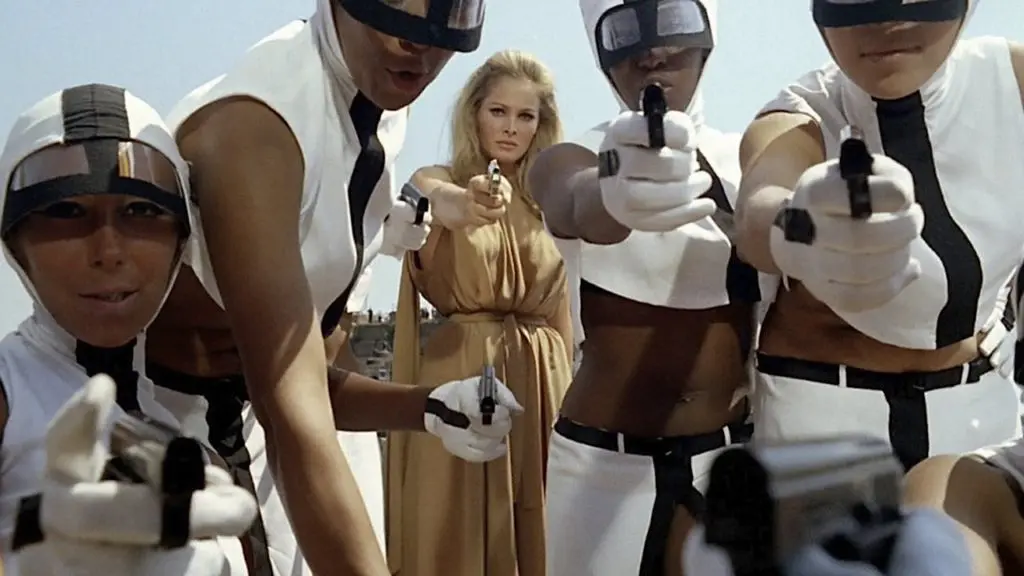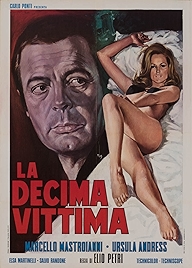The Tenth Victim is a textbook case of a cult film that’s actually no good. Released in 1965 and billed as sci-fi (it barely is), it’s a camp Italian spectacle combining the unique talents of Ursula Andress and Marcello Mastroianni, and just that cocktail – 1965, Italy, sci-fi (ish), Andress and Mastroianni – is plenty of reason for seeing the film.
It’s set in the 21st century, where violence has been outlawed and is now limited to carefully controlled contests between designated Hunters and Victims. These contests, adjudicated by the Ministry of the Big Hunt, are broadcast on TV, where advertisers line up with sponsorship deals – Ming Tea being the product successful Hunters (or Victims) are currently asked to endorse while still fresh from a kill.
As the action opens, Marcello (Mastroianni) and Caroline (Andress) are two successful competitors, who, for their final appearance – win ten times and you’re rich beyond your wildest – will be pitted against each other. But he, being devastatingly world weary and suavely Italian, and she, being a lava-hot American barely dressed in anything, won’t quite play it the way the game is meant to be played. Instead they’ll cat-and-mouse about for the duration of the contest (film) in a potentially lethal form of heavy petting before a grand finale at the Coliseum in Rome, an appropriate venue for modern gladiators.
It’s better seen as satire than sci-fi. For starters it never looks like any other time than 1965, unless the future is also littered with cars like the Citröen DS or the E Type Jaguar. And it’s a very 1960s satirical focus too – the crassness of commodified commercial (ie American) culture, which knows the price of everything and the value of nothing. On the one hand Ming Tea; on the other the Coliseum. Murder as entertainment. TV as the opium of the masses.
Ah, but the style, that’s really what’s on offer here. The sunglasses, the modernist settings, the pop-art furniture, the comic-book backdrops, the cars, the clothes (most people, Andress apart, wear either black or white, or black and white). Trimphones. They have trimphones.
The leads are perfect in their roles and perfectly cast against each other. Mastroianni is playing a variant on the bored playboy that was his forte, his bleach-blond hair knocking years off – he looks much younger here than in 1961’s La Dolce Vita. That he plays it to the hilt rather than phoning it in is a testimony to his professionalism. Andress is a variant on the creature who emerged from the sea in Dr No, at one point in a bikini, at others in garments which might as well have been fashioned from sea mist they are so barely-there. A mannequin come to life, she’s worth looking at from every angle but is also credible as an ice-cool killer who’s got this far in the Big Hunt on her wits rather than her tits.
The influence of this film. How long have you got? The Killer TV Show plot has been repurposed repeatedly, but this is the first outing for an idea that will later resurface in everything from Series 7: The Contenders, to The Running Man, to Battle Royale, to The Hunger Games. And elements of the story are also very familiar too – Andress’s bullet-dispensing silver bikini later turned up in an Austin Powers movie (and a Britney Spears video), and the idea of the Big Hunt Club, where Hunt competitors mingle in relaxed fashion in a strictly off-duty setting, has been borrowed by John Wick.
Directed by Elio Petri, clearly atoning for having dabbled in Italian neo-realism, it takes its garish cues from Sean Connery-era Bond movies, as so many of the spy-fi spoofs of the 1960s did – see the Matt Helm (Dean Martin) and Derek Flint (James Coburn) films for further details – kitsch, camp throwaways made by producers out to exploit a moment and with little regard for posterity.
Frustratingly, and as already said, it’s just no good. There is no plot. Once the characters of Marcello and Caroline have been introduced to each other, there’s the sound of a Tibetan prayer wheel spinning quietly on its axle as nothing at all happens until the big finish. People meet, they talk, their conversations have no consequence. New characters are introduced now and again but they have no impact on anything. Blind plot alleys are driven into and reversed out of. At one point a crocodile is manhandled into a swimming pool. And is never seen again. Emblematic of the entire film, its mouth is tied shut. It’s all meant to be just too cute, I’m guessing, but it isn’t enough. And the post-dubbed dialogue is shocking, even by the awful standards of a lot of 1960s Italian movies.
Still, Ming Tea – Mike Myers fronted a faux band of that name for a while with the Bangles’ Susanna Hoffs and rocker Matthew Sweet. Hang on to The Tenth Victim at that level, as an inspiring mood board for future camp artistic excursions. At that level, it’s perfect. Otherwise…
The Tenth Victim – Watch it/buy it at Amazon
I am an Amazon affiliate
© Steve Morrissey 2021


